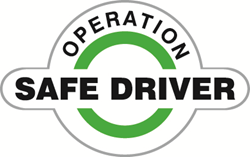Commercial Vehicle Safety Alliance Releases Results from Operation Safe Driver Week
The Operation Safe Driver week-long campaign aims to combat the number of deaths and injuries from crashes involving large trucks, buses and cars.
Law enforcement officers pulled over 59,080 commercial and passenger vehicle drivers during the Commercial Vehicle Safety Alliance’s (CVSA) 2014 Operation Safe Driver mobilization week. In addition, 24,184 North American Standard Roadside Inspections were conducted by CVSA-Certified Inspectors on commercial drivers and vehicles.
During the week-long Operation Safe Driver campaign, conducted Oct. 19-25, 2014, data was collected by 4,337 law enforcement officials at 1,549 locations across the United States and Canada. There also were outreach events throughout the week at high schools, state capitals, state fairs, truck rodeos, sporting events and other locations.
Officers found that non-commercial motor vehicle (non-CMV) drivers speed significantly more so than commercial motor vehicle (CMV) drivers. Non-CMV drivers were issued a warning or citation for speeding 52.3 percent of the time, versus 5.8 percent for CMV drivers.
The top five warnings and citations issued to CMV drivers were: (1) speeding, (2) failure to use a safety belt, (3) failure to obey traffic control devices, (4) improper lane change, and (5) following too closely.
The top five warnings and citations issued to non-CMV drivers were: (1) speeding, (2) failure to use a safety belt, (3) failure to obey a traffic control device, (4) possession/use/under the influence of alcohol, and (5) improper lane change.
“Operation Safe Driver takes a targeted approach to identifying and taking action on problem driver behaviors exhibited by commercial drivers and passenger vehicle drivers,” said CVSA President Captain William Reese of the Idaho State Police. “CVSA members and our partners are having an impact by applying effective enforcement and education strategies to ultimately improve safety for all motorists.”
The following is a closer look at the numbers:
In 2014, 19,980 CMV traffic enforcement contacts were made; the total was 29,048 in 2013.
Non-CMV traffic enforcement contacts totaled 39,100 in 2014; there were 45,717 in 2013.
Roadside inspections totaled 24,184 in 2014 versus 44,882 in 2013.
The number of warnings and citations per contact to CMV drivers was 0.45 whereas the number of warnings/citations per contact to non-CMV drivers was 1.27, nearly triple the amount.
The percentage of warnings and citations issued to CMV drivers for speeding decreased from 7.3 percent in 2013 to 5.8 percent in 2014. It was 10.8 percent in 2012.
The percentage of warnings and citations issued to non-CMV drivers for speeding decreased from 56.0 percent in 2013 to 52.3 percent in 2014.
The percentage of warnings and citations issued to CMV drivers for failing to obey traffic control devices increased from 1.8 percent in 2013 to 2.5 percent in 2014.
The percentage of non-CMV drivers issued warnings and citations for alcohol possession/use/under the influence in 2014 was 1.7 percent; in 2013, it was 1.5 percent.
The percentage of warnings and citations issued to CMV drivers in 2014 for failure to use seat belts was 2.8 percent. It was 2.9 percent in 2013 and 3.8 percent in 2012. For non-CMV drivers, the percentage increased from 2.6 percent in 2013 to 4.1 percent in 2014.
During the 2014 campaign, Federal and State safety investigators also used driver performance data from FMCSA’s Compliance, Safety, Accountability (CSA) algorithm to target motor carriers for on-site interventions. As a result, 193 compliance Investigations were conducted during Operation Safe Driver 2014, and 23 percent of the motor carriers investigated received proposed Unsatisfactory Safety Ratings (versus 15 percent for all of FY2014), while another 53 percent received proposed Conditional Safety Ratings (versus 28 percent for FY2014). In addition, 46 percent of the investigations resulted in enforcement actions (versus 33 percent for FY2014).
“CVSA and its members are vital FMCSA partners, working to protect the motoring public from unsafe trucks and buses so that everyone traveling our highways and roads arrives at their destination safely,” said FMCSA Acting Administrator Scott Darling. “I thank the dedicated commercial vehicle inspectors and law enforcement officers for their professionalism and service, not only during Operation Safe Driver Week, but every day of the year.”
Operation Safe Driver was launched in 2007 by CVSA, in partnership with the Federal Motor Carrier Safety Administration (FMCSA) and with support from industry and a number of other transportation safety organizations, to combat the number of deaths resulting from crashes involving large trucks, buses and cars by improving the behavior of all drivers operating in an unsafe manner — either by, in or around commercial vehicles — and initiating educational and enforcement strategies to address individuals exhibiting high-risk behaviors. For more information on Operation Safe Driver, visit http://www.operationsafedriver.org.
About CVSA
The Commercial Vehicle Safety Alliance (CVSA) is an international not-for-profit organization comprised of local, state, provincial, territorial, and federal motor carrier safety officials and industry representatives from the United States, Canada, and Mexico. Our mission is to promote commercial motor vehicle safety and security by providing leadership to enforcement, industry and policy-makers. The Alliance actively monitors, evaluates, and identifies solutions to potentially unsafe transportation processes and procedures related to driver and vehicle safety requirements most often associated with commercial motor vehicle crashes. In addition, CVSA has several hundred associate members who are committed to helping the Alliance achieve its goals: uniformity, compatibility and reciprocity of commercial vehicle inspections, and enforcement activities throughout North America by individuals dedicated to highway safety and security. For more information, visit http://www.cvsa.org.
By CVSA


